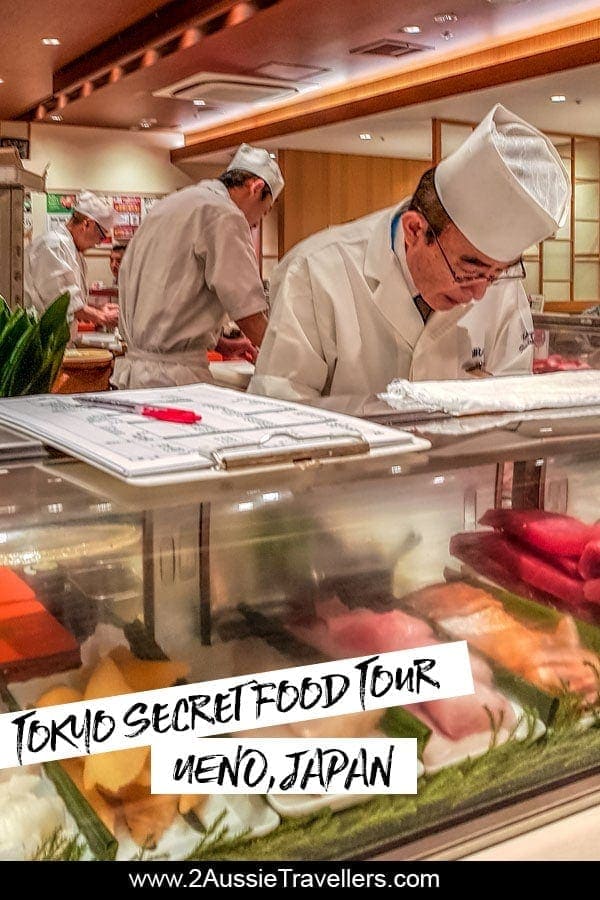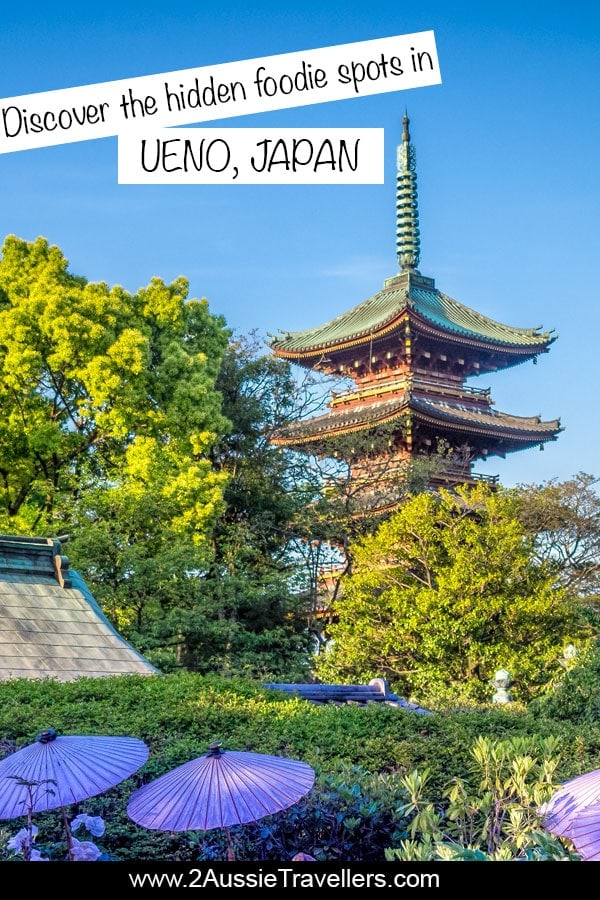As a foodie with a long-standing love of Japan, I couldn’t think of a better way to spend our first day back in Tokyo than by joining Tokyo Secret Food Tours to discover the highlights of Ueno food culture. We were both looking forward to learning a bit more about the culinary culture of the city and of course, tasting some of the delicious food on offer.
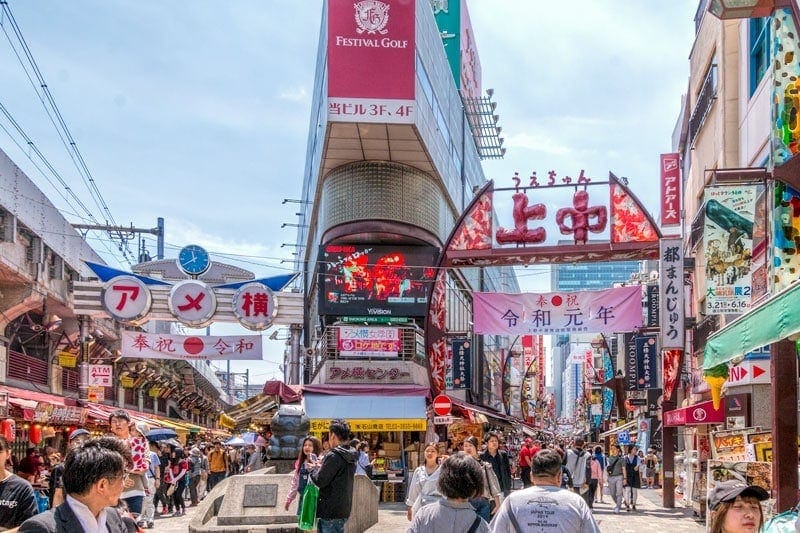
Ueno is an area we’d explored and enjoyed on previous trips both in winter and during the cherry blossom of early spring so it was interesting to come back and spend more time here with a local who would be able to share it through their eyes.
This area does have one very special foodie claim to fame for me, it was the first place I ever tried okonomiyaki. It was many years ago and I fell totally in love with this intriguing Japanese ‘fast food’. We were in Ueno park just past the peak of sakura season as the blossoms were starting to fly around in the breeze. It was just so stunning that we decided to eat there rather than leaving to find a restaurant and we stopped at a small food stall down by the lake.
The stall offered only one thing on its menu and I can’t say I immediately had high hopes for the giant pile of cabbage on the grill but this is one of those magic dishes that whether it’s from a humble food stall or a gleaming modern izakaya it always seems to be so much more than the sum of its parts. I definitely went into this foodie tour with high hopes that I might discover another culinary unicorn on this trip back to Ueno.
Looking for more ideas for things to do in Ueno?
Read more: If you are interested in Ueno as an area to explore or even to base yourself during your stay in Tokyo, don’t miss our guide to where to eat, stay and play in Ueno.
Table of Contents
Getting to Ueno
The meetup point for the tour is directly outside Ueno Station. It’s explained in detail on the ticket exactly when and where to meet and there was also an email the day before making sure we had all the information easily to hand. It all becomes very clear when you get there.
We are pretty much always early, especially if you mention food but Tomoko had beaten us to it and was waiting for us and the rest of our tour group, a couple from the USA, exactly where they described. With her orange ‘secret tours’ umbrella, she was very easy to find. Ueno station is a stop for both the subway and JR trains, it’s also connected below ground to the nearby Keisei Line.
We had returned to the Hotel New Otani for this visit to Tokyo and were able to take the Ginza subway line directly from Akasaka-Mitsuke station to the G16 (Ueno) stop. It takes around 20 minutes and costs Y200.
For travel around Tokyo, we carry an IC Card, any of the PASMO, SUICA or ICOCA work right across Japan, it’s far more convenient than using individual tickets and can be used across a wide variety of transport, vending machines and stores. While the Japan Rail Pass can offer great value it’s not the right solution for every visitor but an IC card has always come in handy.
An introduction to local Ueno food culture
Starting off with sushi
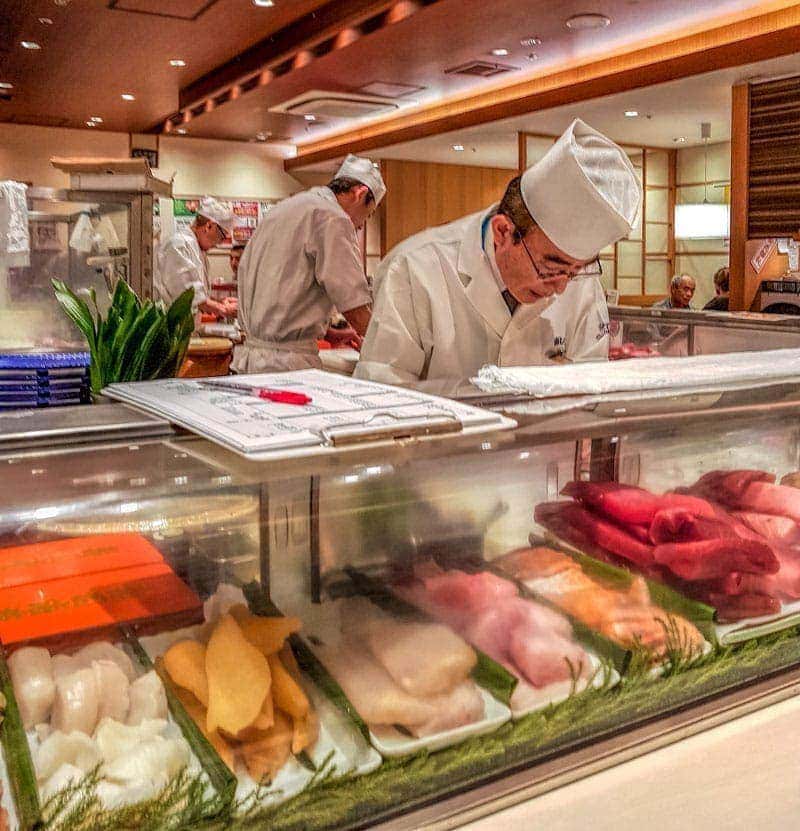
As soon as introductions were done it was into the food tasting. It wasn’t far to our first stop which was a sushi restaurant where our choice was prepared freshly in front of us by the chef. Which pieces we ordered were our choice but I went with Tomoko’s suggestion to try the medium-fatty tuna, my favourite for flavour and the way it almost melts in the mouth, then contrasted it with a leaner tuna cut and raw prawn, they were also delicious but it’s hard to go past chūtoro when it’s available.
We were able to watch the chef prepare it in front of us adding the perfect amount of wasabi for each piece to make each bite delicious, there was no need to add more.
We also picked up a few useful tips, like it is perfectly acceptable to eat sushi with your hands. I’d heard this before but had thought it was a concession for tourists but even locals do it. It certainly makes it easier to carry out the second tip which is to put a very small amount of soy sauce into the bowl and then swipe the fish side of the sushi through the sauce to get a small amount on each piece.
By dipping only the fish side of the nigiri rather than the rice it will not fall apart into the sauce or as you try to eat it. It also keeps the flavours balanced as the rice will absorb too much of the salty sauce.
Ameyoko Market
Our next stop is Ameyoko Market which starts just opposite the Ueno train station. There’s been a market here for many years. After the war, it was a popular spot selling black market goods when so little was available but it thrives today with both the locals and tourists loving a visit here.
Ameyoko is made up of two words, ‘Yoko’ means market and the name ‘Ame’ is a play on both the words American reflecting that post-war period and also meaning sweet as you’ll find many sweet options here. We spotted many traditional favourites such as mochi and dango alongside modern packaged omiyage (gifting souvenirs) and KitKats.
One of our interesting stops on the tour is a 200-year-old dashi shop selling all the delicious components of this complex broth to make at home. Sadly they can’t be taken back to Australia with us but the bricks of bonito, shaving boxes for preparing it fresh, dried mushrooms and a selection of seaweed all looked delicious and had me still mentally working through recipes in my head as we walked into our next stop at a tea shop.
The fragrance of tea brought me back to the present. We were offered a tasting of a bright and vibrant sencha made from an early picking of the leaves which had a fresh and uplifting taste and aroma, I love the way that even tastings are done in a ceramic cup so you can enjoy it as it should be, tea from plastic or paper just isn’t the same.
With all the variety on offer, I decided to pick up a packet that was a blend of my favourite genmai with matcha to take home, something that I can’t buy in my local Asian marketplace or teashops. We were all offered a tasting of the interesting blend as the owner demonstrated the correct proportions for me to mix in my teapot at home.
Trying out street food Ueno style
Heading around a corner the market streets get narrower and we find our next stop. It’s hard to pick out what they are selling here if you were just passing but the queue just keeps getting longer which tells you it is probably good.
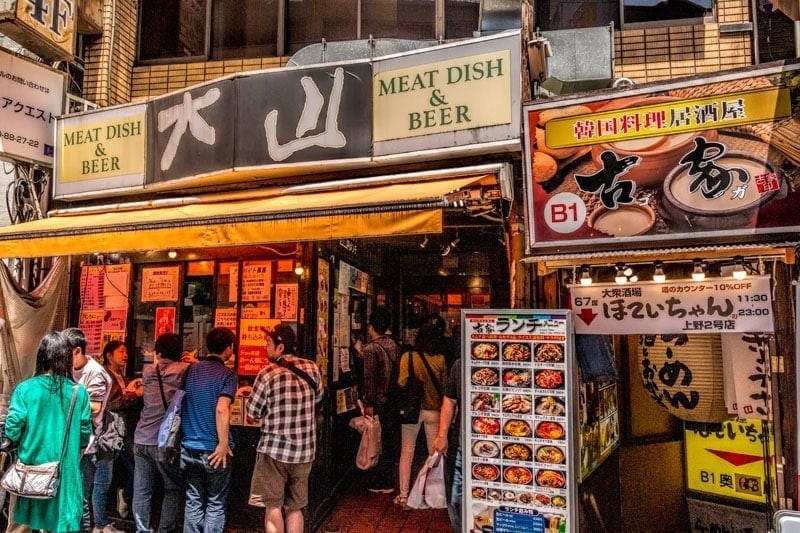
The small shop is known for its croquette style snack called menchi-katsu in Japanese, we tried one of the hot crispy meat patties and it makes a great flavourful hot snack. They are also a popular choice for busy mums to take home, add rice and vegetables and you have dinner on the table quickly for hungry children. I can imagine the kids of Ueno looking forward to the days when mum’s in a hurry. I don’t eat fried food often but these are very tasty.
A secret restaurant below ground
Already feeling well-fed our next stop is a restaurant for lunch. In Japan you quickly learn that to find good food you need to look up and down, restaurants other than chain stores and fast food are hardly ever at eye level in the city but I am always still amazed by what we miss.
Today’s restaurant is a fabulous choice hidden away downstairs it feels like we have entered an oasis of calm after the busy streets. We are guided to our table by an immaculate woman in a simple but elegant kimono. Like the rest of the city, Ueno is full of contrasts and surprises.
At our lunch stop they serve Teishaku, a complete meal set and we are encouraged to order from their specialties, I choose the seasonal Spring menu while Drew opts for the sukiyaki. Each has a variety of dishes and is a tasting experience all of its own.
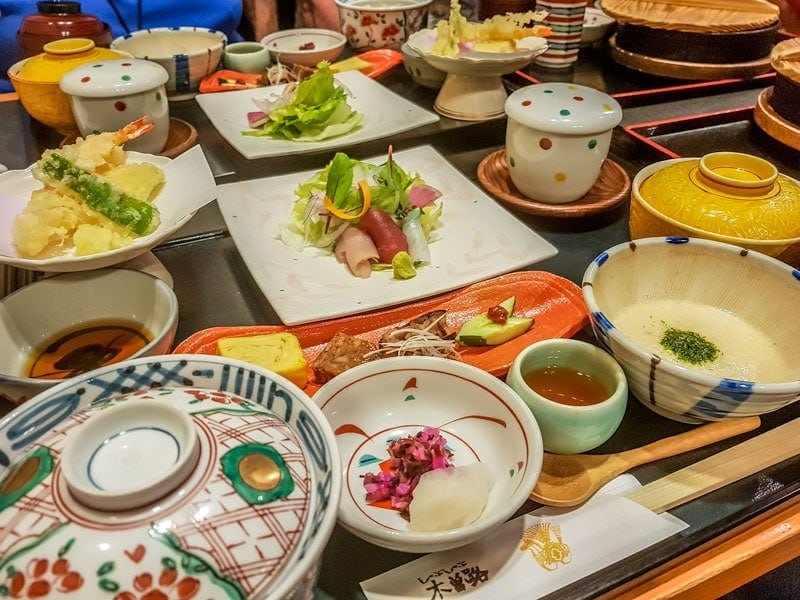
The seasonal selection includes some finely sliced sashimi on a salad with a bowl of dressing that we are encouraged to pour over it, rather than drowning the flavours as I had expected it is light and enhances the subtle fish. Tempura, rice, pickles and vegetables are part of the meal each served in its own dishes.
A selection of tofu pieces in another dish doesn’t look like tofu as I know it but offers different flavours and textures that are delicious. Under a lid of another pot appears to be a cream caramel dessert but it is a savoury egg custard, the consistency is surprisingly smooth and umami in flavour with hidden surprises buried below, I find shitake mushroom and chicken in my seasonal set.
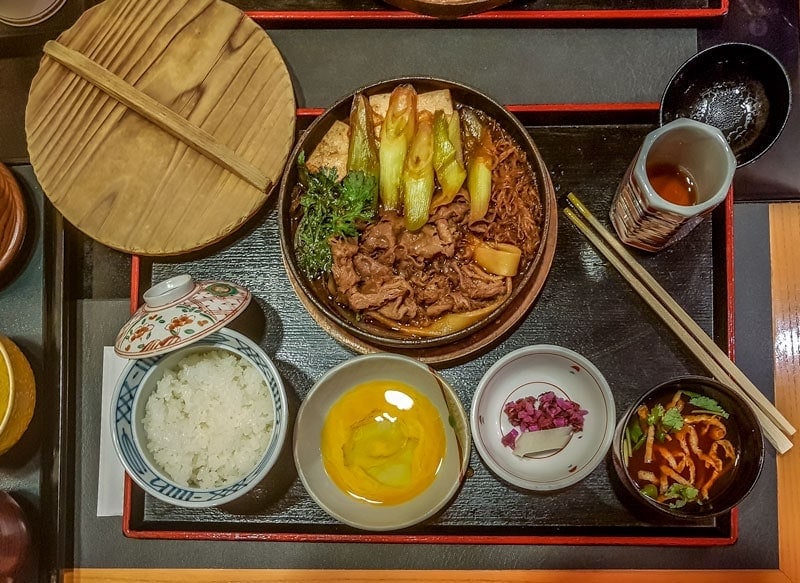
Drew’s sukiyaki is very different but equally good. Finely cut tender beef, tofu, thick green onions almost the size of small leeks and tofu are in the pot. There are also a variety of noodles, thick hand-cut ones and a type of konyuaku noodle made with a local yam that has very little flavour on its own but soaks up the delicious juices from the pot without becoming soggy.
There are also some interesting greens in the bowl that I learn are chrysanthemum leaves, something I’d seen for sale last year in Aomori but not had the opportunity to try.
The dessert in typical Japanese fashion is visually beautiful, a small cube, half red and half white that perfectly encapsulates the flavours of summer, strawberries and cream, exactly the right sized portion to end the meal but not enough to be sickly in the middle of the day.
Walking through the park
Feeling extremely full at this point and wondering how we would possibly complete the remaining tastings on the tour we head out for a walk through Ueno Park and learn a bit of its history. Although we’ve walked through here before I wasn’t aware of its strategic importance in Japan and Tokyo’s history. A major battle was fought on this site in 1868 and the first public park in Japan was founded here shortly after in 1876.
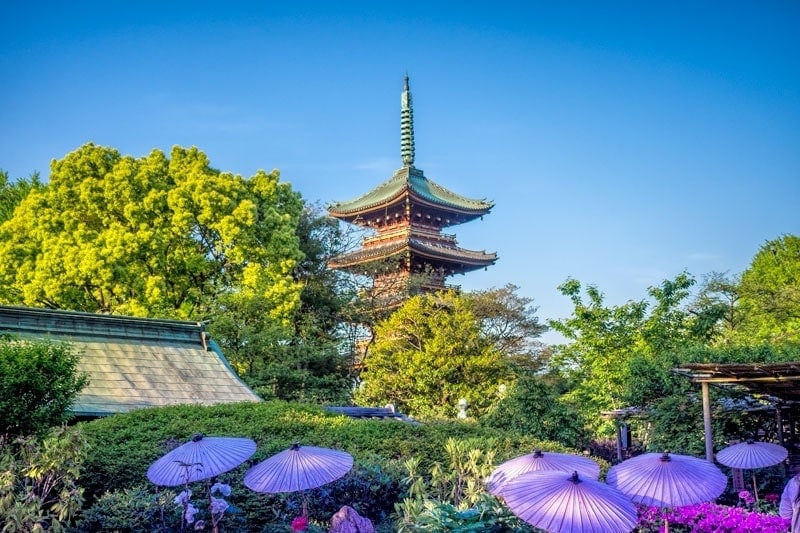
There was once a massive temple complex here but today only 3 of those buildings remain and the most dominant today due to its height is the pagoda. The temple was built for the 1st and 3rd shogun and was the most prosperous in all of Tokyo. The head priest designed it to mirror aspects of Kiyomizudera temple with its cantilevered viewing deck bringing a little touch of Kyoto to the people of Tokyo.
Gyoza
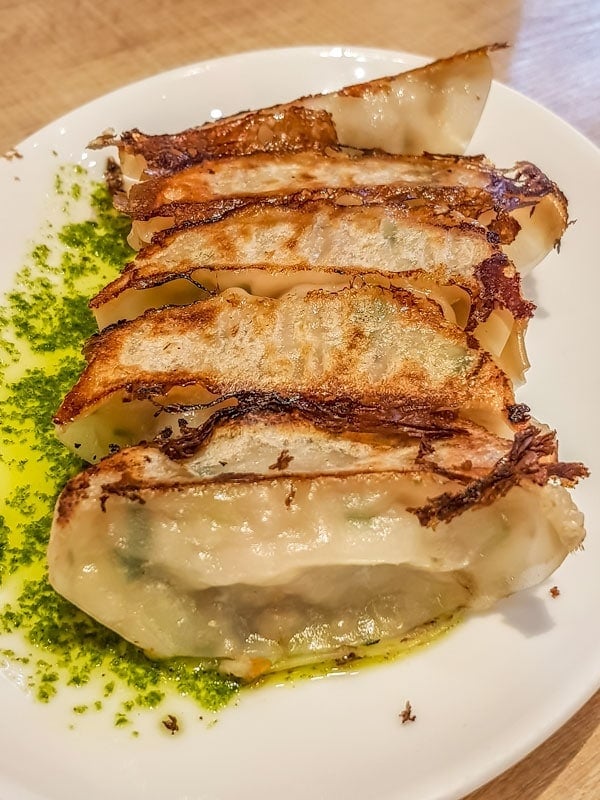
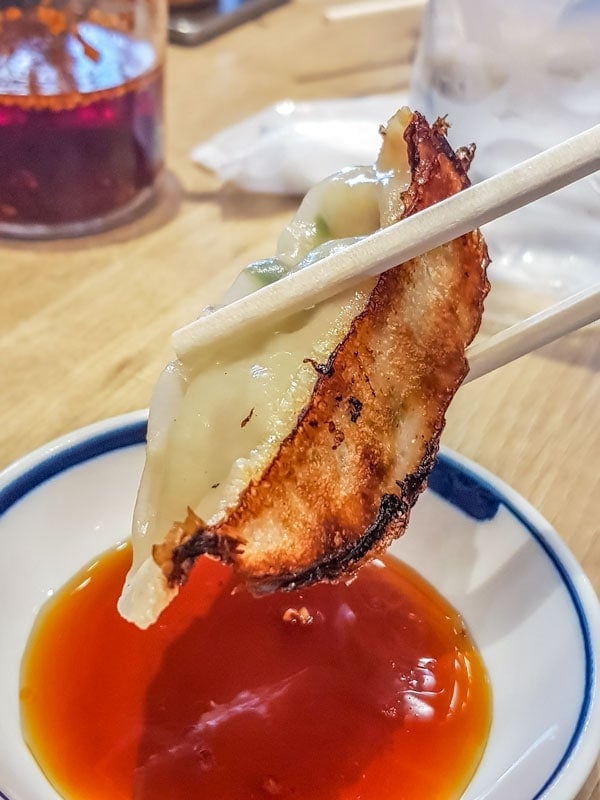
Back on the streets of Ueno, we head into a large casual corner izakaya specialising in gyoza. Gyoza is a form of dumpling that originated in China but has become a firm favourite in Japan and part of the Ueno food culture. Tomoko orders a couple of plates for our table to share and I try to make a mental note of where we are so we can find this place again. I’m a huge fan of gyoza and the ones here are really very good.
Yakitori and Sake
Our next stop is somewhere we just wouldn’t have gone on our own. We always love the look of these small local bars but the language barrier is significant when you see all the menus are in Japanese and signs in the doorway advise that their staff don’t speak English or other languages.
This is where having your local guide not only do the ordering in Japanese but to read you the menu comes into its own. You could no doubt still head in for a ‘nama chu’, a mid-sized draught beer but ordering food would be a challenge with our very limited language skills.
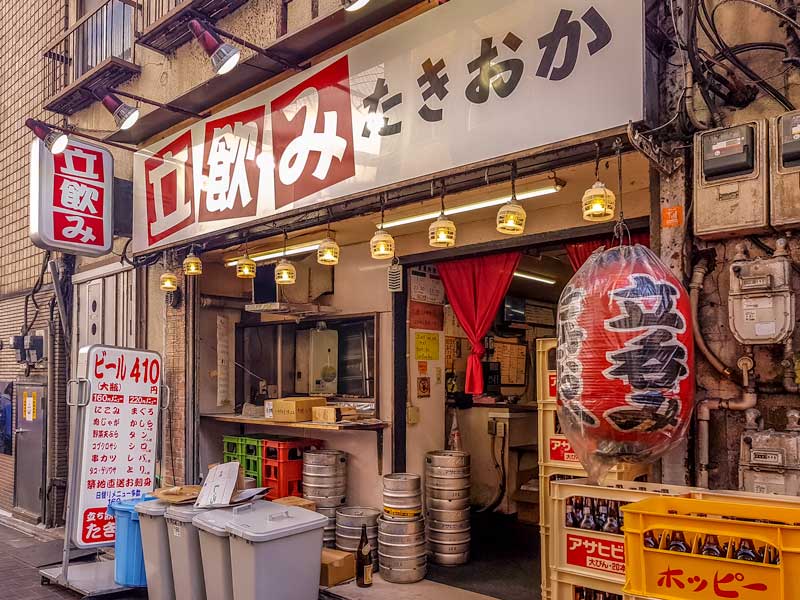
Despite it being so busy they still found a table in the standing bar for us to enjoy some typical local drinks and yakitori. Yakitori are skewers of meat and come in a wide variety of options, technically when you break down the word ‘yaki’ means grilled and ‘tori’ is a bird but although chicken is still the most popular option it’s not the only one available.
In Japan you will notice that they use all parts of the bird, we were very tame with our mixed platter and the green onion and lightly salted chicken thigh was our favourite but you can be a lot more adventurous if chicken liver, tail, cartilage and skin appeal. They are popular in Japan but have an acquired taste for the western palate.
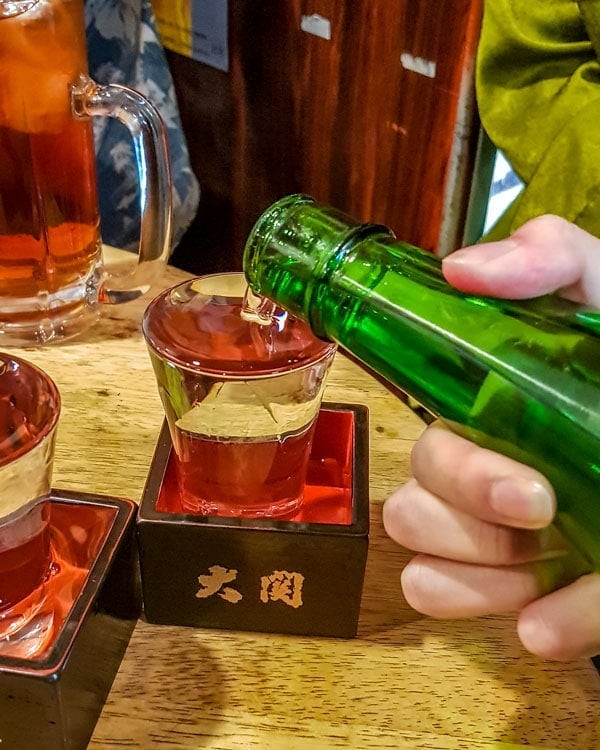

Our group ordered a variety of drinks to try, from a very generously poured sake to the local beer on tap. I took the opportunity for my first chuhai of the trip, a cocktail of a common Japanese citrus fruit called yuzu and shochu, which is clear Japanese alcohol. It’s topped off with soda water to make a nice refreshing drink but still packs a bit of a punch for this lightweight.
Ending on a sweet note
Heading back towards the station to end the tour we stopped off for a sweet treat to end our afternoon of indulgence. There was a choice of different fruit available but we both choose a skewer of delicious sweet local strawberries, they are in season in Japan from January through to May but despite being late in the season they were still big, juicy and very sweet, a perfect end to the day.
We ended our tour not far from Ueno Station where we started. The total tour was closer to 4-hours than 3 due to the crowds on Golden Week but Tomoko did check with everyone midway through the day that we were OK with the time running a little later to ensure we still fitted in all the stops.
Booking your own Tokyo food tour
If you’re interested in a Tokyo food tour and exploring the area of Ueno with its diverse food culture then we really enjoyed this one. Tomoko is a fabulous host with a personal love of that part of the city, she knows the local businesses and market traders and deals well with the adjusting on the fly when things are busy or anyone had special requirements.
She even gave us a little sneak peek at one of her secret spots for family tours where she takes the little ones so the grown-ups can enjoy the bar experience and it’s something they would love, I headed back for a second look at all the cuteness myself.
Book tickets and read more reviews from the tour
Other things to do in the area
With a little more time to spend in the area, you might choose to head back to the park. It’s a huge size and there will always be more to see. There are regular events and festivals held here and it’s especially beautiful and busy during the annual cherry blossom time.
Within the park, you’ll find Ueno Zoo which is best known for its giant Pandas who are here on a long term holiday from China. They have recently added little panda cubs to the dwindling population so for a limited time they can be seen on display here too.
Surrounding the park is the cultural precinct with a number of excellent museums and galleries. We particularly like the National Museum and its special exhibit of the treasures of Horuju, a temple in Nara, the ancient capital of Japan. These can be a good option to keep in mind if you strike a wet day in the city.
Asakusa is another area of Tokyo that is very close to Ueno and ideal to combine for a day of exploring. It’s a 5-minute subway ride on the Ginza line and you can even walk from one to the other easily in around 30 minutes. It’s about a 2km walk and if you go via the popular Kappabashi Shopping Street the foodies in the family will love it, this is the place to stock up on all those great culinary tools you are seeing, from plates and bowls to tea sets, knives and even that plastic food you see outside many restaurants can be bought through here.
Read more: Our comprehensive guide to exploring Ueno
If you are planning on heading to Tokyo find out why we love Asakusa and many of the fun things to do there and tips for exploring for Shibuya in some of our other guides. Do you have a favourite Japanese food or an area of Tokyo where you find the best restaurants? Share your questions and tips in the comments below.
Save these images to Pinterest for future reference
